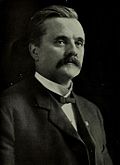| Member | Party | Years of service | Cong
ress | Electoral history |
|---|
| District established March 4, 1893 |

William A. McKeighan
(Red Cloud) | Populist | March 4, 1893 –
March 3, 1895 | 53rd | Redistricted from the 2nd district and re-elected in 1892.
Lost re-election. |

William E. Andrews
(Hastings) | Republican | March 4, 1895 –
March 3, 1897 | 54th | Elected in 1894.
Lost re-election. |

Roderick Dhu Sutherland
(Nelson) | Populist | March 4, 1897 –
March 3, 1901 | 55th
56th | Elected in 1896.
Re-elected in 1898.
Retired. |

Ashton C. Shallenberger
(Alma) | Democratic | March 4, 1901 –
March 3, 1903 | 57th | Elected in 1900.
Lost re-election. |

George W. Norris
(McCook) | Republican | March 4, 1903 –
March 3, 1913 | 58th
59th
60th
61st
62nd | Elected in 1902.
Re-elected in 1904.
Re-elected in 1906.
Re-elected in 1908.
Re-elected in 1910.
Retired to run for U.S. senator. |

Silas Reynolds Barton
(Grand Island) | Republican | March 4, 1913 –
March 3, 1915 | 63rd | Elected in 1912.
Lost re-election. |

Ashton C. Shallenberger
(Alma) | Democratic | March 4, 1915 –
March 3, 1919 | 64th
65th | Elected in 1914.
Re-elected in 1916.
Lost re-election. |

William E. Andrews
(Hastings) | Republican | March 4, 1919 –
March 3, 1923 | 66th
67th | Elected in 1918.
Re-elected in 1920.
Lost re-election. |

Ashton C. Shallenberger
(Alma) | Democratic | March 4, 1923 –
March 3, 1929 | 68th
69th
70th | Elected in 1922.
Re-elected in 1924.
Re-elected in 1926.
Lost re-election. |

Fred Gustus Johnson
(Hastings) | Republican | March 4, 1929 –
March 3, 1931 | 71st | Elected in 1928.
Lost re-election. |

Ashton C. Shallenberger
(Alma) | Democratic | March 4, 1931 –
March 3, 1933 | 72nd | Elected in 1930.
Redistricted to the 4th district . |

Terry Carpenter
(Scottsbluff) | Democratic | March 4, 1933 –
January 3, 1935 | 73rd | Elected in 1932.
Retired to run for governor. |

Harry B. Coffee
(Chadron) | Democratic | January 3, 1935 –
January 3, 1943 | 74th
75th
76th
77th | Elected in 1934.
Re-elected in 1936.
Re-elected in 1938.
Re-elected in 1940.
Retired to run for U.S. senator. |
| District eliminated January 3, 1943 |








